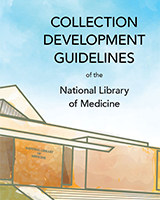NCBI Bookshelf. A service of the National Library of Medicine, National Institutes of Health.
Collection Development Guidelines of the National Library of Medicine [Internet]. Bethesda (MD): National Library of Medicine (US); 2019-.

Collection Development Guidelines of the National Library of Medicine [Internet].
Show detailsAtlases are works consisting of collections of images, usually with explanatory text or captions. In medicine, atlases usually contain drawings, radiological images, diagrams, or photographs of the body, various health conditions, surgical procedures, etc. They are used for the education of health professionals, and as practical references for clinical diagnosis and treatment. Atlases also document the level of knowledge about anatomy during a historical period, and sometimes reflect the medical philosophy of a culture.
NLM selectively collects medical and anatomical atlases likely to be of interest to U.S. health professionals and to historians of medicine and science. Selection criteria include quality of graphics, current research value, and potential historical importance. For the historical record, atlases produced or translated in non-Western countries are of particular interest, as are any works that document national differences in the portrayal of anatomical subjects.
- Atlases - Collection Development Guidelines of the National Library of MedicineAtlases - Collection Development Guidelines of the National Library of Medicine
- Histology - Collection Development Guidelines of the National Library of Medicin...Histology - Collection Development Guidelines of the National Library of Medicine
- Physiology - Collection Development Guidelines of the National Library of Medici...Physiology - Collection Development Guidelines of the National Library of Medicine
- 16α-[18F]Fluoro-17β-estradiol - Molecular Imaging and Contrast Agent Database (M...16α-[18F]Fluoro-17β-estradiol - Molecular Imaging and Contrast Agent Database (MICAD)
- Receptors, Islet Amyloid PolypeptideReceptors, Islet Amyloid PolypeptideG-protein coupled receptors that are formed through the dimerization of the CALCITONIN RECEPTOR with a RECEPTOR ACTIVITY-MODIFYING PROTEIN. Their affinity for ISLET AMYLOID PO...<br/>Year introduced: 2011MeSH
Your browsing activity is empty.
Activity recording is turned off.
See more...